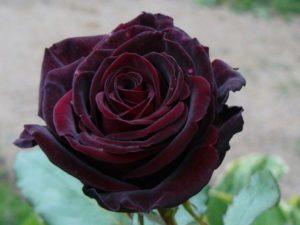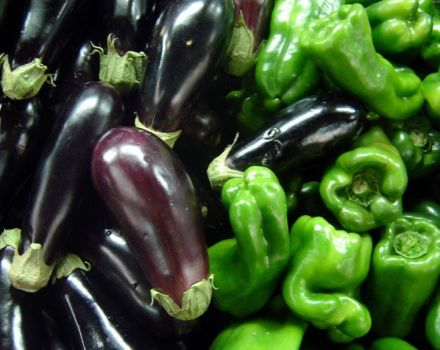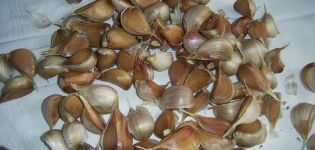Description of the Gloria Day rose variety, planting, growing and care
Due to its beauty and majesty, the rose has been considered the favorite of the garden for many years. Many varieties have been bred by breeders, and the starting material for most of them is a rose called Gloria Day. It is deservedly called the rose of the 20th century. She has repeatedly won various international competitions and exhibitions.
Description
Gloria Dei is a hybrid tea variety. The bush is capable of reaching a height of 1.2 meters. It is slightly spreading in shape, with straight, leafy stems. There are large but sparse thorns along the entire length of the shoots. The leaves of the rose are deep green in color, there are jagged edges along the edges. Her buds are large, in full dissolution reach 20 centimeters in diameter.
Gloria Day's double flowers have an interesting feature: they are able to change color during their growth. The main color is lemon yellow, this is how the core of the bud is colored. At the edges of the inflorescences are pale pink or white. At the beginning of budding, the petals are colored yellowish-green, gradually becoming bright yellow. In full dissolution, the inflorescences acquire a pink color from the edges to the middle.
Characteristic
Gloria Day flowers have a delicate aroma with hints of fruit and honey. It changes under different growing conditions. The variety is resistant to most species diseases. The rose will show its best decorative qualities when growing it in an area well-lit by the sun's rays. Gloria Day is hardy, but if the winter is too cold it needs to be covered.
Note! In case of a sharp thaw, the shelter must be removed to prevent the roots from drying out.
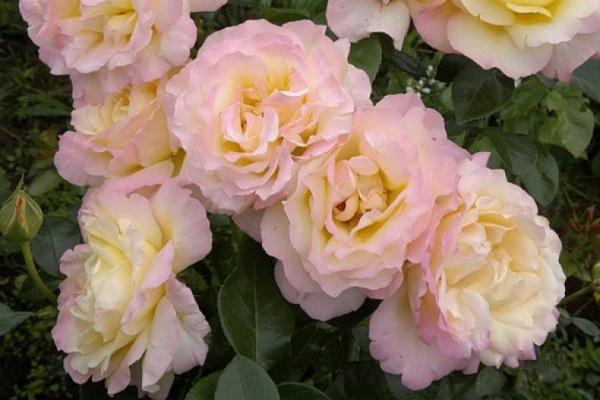
Rose story
Gloria Day was bred by the French - father and son Meiyan in the 30s of the 20th century. They named this variety "Madame Meiyan", in honor of the wife and mother of the breeders. The cuttings of the rose were sent to nurseries in Germany, Italy, the USA to get acquainted with it, to receive feedback. But the contacts were interrupted by the war.
Each country that received the cutting was able to save it. In Italy, the rose was named Gioia ̶ Delight, the Americans gave the name Peace ̶ Peace. In Germany, experts named it Gloria Dei, which translates as "Glory to the Lord." This name has also taken root in Russian-speaking countries.
Varieties
For several decades, Gloria Day has been the best hybrid tea type of roses. She is not only beautiful, but also resistant to many diseases. Almost 400 varieties of roses have been developed on its basis. The following varieties have gained the greatest popularity:
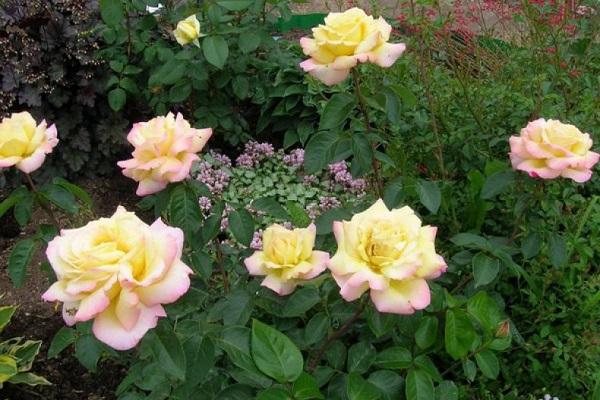
- Gold Crown;
- Talking sun;
- Princess of Monaco;
- Fiery world;
- Reception of guests in the garden.
In addition, breeders have bred climbing rose Climing Gloria Day. She is able to reach a height of 3 meters. The color of the buds is the same as that of the bush species. Climbing rose blooms, starting in June and ending with the first cold weather.
Additional Information. In Catholicism, the red rose symbolizes earthly life, white - heavenly.

Advantages and disadvantages
Gloria Day is appreciated for its decorative look. In addition, the following qualities are among the advantages:
- resistance to most species diseases;
- unpretentious care;
- the ability to bloom for a long time;
- resistance to large amounts of precipitation.
Among the shortcomings, one can single out the need for roses for shelter for the winter. But, given that other varieties also need it, this is not a significant disadvantage.
Growing features
To grow a rose with a pronounced decorative look, you must adhere to certain rules.
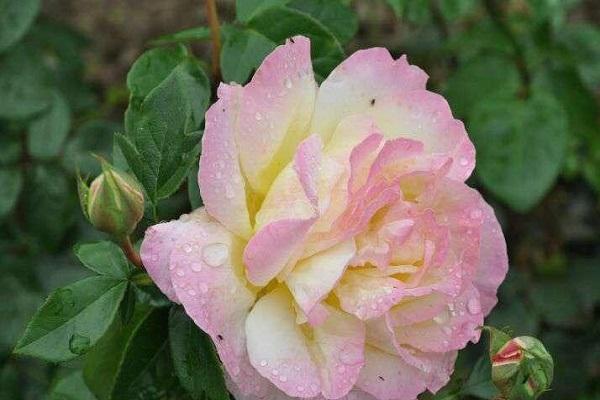
When to plant
The Gloria Day rose is planted in the spring, before bud break. By the time of planting, the soil should completely thaw and warm up. In warm regions, bushes can also be planted in the fall. The optimal time for this is September. The plants planted this month have time to rooted and get stronger before the winter cold.
Preparation of planting material
Before the planting procedure, the seedlings are pruned. There should be no more than 3-4 strong trunks on the bush, which are shortened to 10-15 centimeters. As a result, 2-4 buds remain on each shoot. The roots of Gloria Day are trimmed so that small branches remain on them. To prevent drying out, the root system is dipped in a mash, consisting of cow dung (1 part) and clay (2 parts).

Choosing a place in the garden and planting
The place where Gloria Day will grow must meet the following requirements:
- it should be well lit by the sun, especially in the morning;
- be protected from drafts;
- the site must be selected with a slope to the south;
- the soil should be nutritious, light, moisture-permeable;
- the predecessors should not be roses.
To facilitate the care of roses, they are planted in rows. Landing is done as follows:
- the root system is lowered for 1 hour into a bucket of water in which a growth stimulant is dissolved;
- a hole is dug 60 × 60 centimeters in size;
- drainage is laid on its bottom, consisting of expanded clay, small stones, sand;
- the substrate is poured on top;
- the roots are straightened, and the seedlings are placed in the planting hole so that the grafting site is 3-5 centimeters below the ground level;
- the plant is watered, then spud to a height of 15 centimeters to prevent drying out.
When the seedlings start and the buds start to grow, they will be bored. The soil in the root circle is mulched with mown grass or peat with a layer of 3-5 centimeters.

Care advice
Throughout the season, the Gloria Day rose requires some care.
Watering
A lack of moisture will adversely affect the plant: the brightness and juiciness of leaves and buds will disappear. An overabundance of it can lead to a disease of plantings with various rot. Therefore, it is necessary to water the rose, depending on the dryness of the soil, 1-2 times a week, spilling 5-7 liters of water under each bush. The best time for the procedure is in the morning.
Important! Roses should not be watered at noon, otherwise the leaves will burn with droplets of moisture.
Top dressing
The first feeding is done in the spring, during the budding period, with organic fertilizers. The land is pre-watered with plain water. This is done to prevent root burns.The second time the bushes are fertilized at the end of July with mineral fertilizing, and again - at the beginning of September to prepare the bushes for winter.

Pruning
This procedure solves the following tasks:
- Forms the crown of a bush.
- Sets the shoots in the desired direction: if the cut is made with a slope from the outer bud, new shoots will grow outward, if from the inner bud (for example, to straighten drooping branches) - inward.
- Performs a sanitary function. This removes old, sick, weak shoots.
- Revives sleeping branches.
The stems are cut with a sharp, disinfected instrument. The cut is made at a distance of 0.5 centimeters from the kidney.

Protection from diseases and pests
Gloria Day is not very susceptible to diseases, but still they are. This is most often due to improper care. With an excess of moisture, the rose is affected by some rot. This is also due to too thickened plantings, excess nitrogen fertilizers. In a diseased plant, the affected parts are cut off, then it is sprayed with a fungicide.
Too dry air is a favorable environment for the development of spider mites. Another common pest of Gloria Day is aphids. To prevent the appearance of various harmful insects, it is necessary to carefully remove all foliage and weeds from the root circle. With a large invasion of pests, the bushes are sprayed with insecticides.
Flower cultivation
Reproduction of Gloria Day at home is done in the following ways:
- Cuttings. This is the most common method among florists. To do this, at an angle of 45 °, the shoot is cut from the bottom of the bush, which is then divided into 3-4 parts. Each of the divisions should have 3-4 internodes. The cuttings are first rooted in water, or immediately planted in the ground and covered with a glass container.
- Layers. The lower shoots are pinned to the ground, then covered with earth. The place where the branches touch the ground is constantly moistened. When roots appear on the shoots, they are separated from the mother plant and planted in separate holes.
- Vaccination. The procedure is carried out by grafting a cuttings or buds onto the root of the rosehip.
Reproduction of Gloria Day by seeds is a laborious process and is usually not used by gardeners at home. This method is used by breeders to breed hybrids.

Application in landscape design
Gloria Day is a versatile rose variety, both in combination with other green spaces and growing as a tapeworm. If the bush is planted alone, then a lawn is sown around it, against which the rose will look like a bright spot. She herself will be the middle plan for taller plants. Planting serves as a decoration for squares, parks, flower beds, rock gardens.
Advice! A combination of a rose with conifers will look mutually advantageous.
Rose Gloria Day is the most common hybrid tea variety. It is highly decorative and unpretentious, which made it popular all over the world. It is planted to decorate the garden and is also used as a cutting plant.
